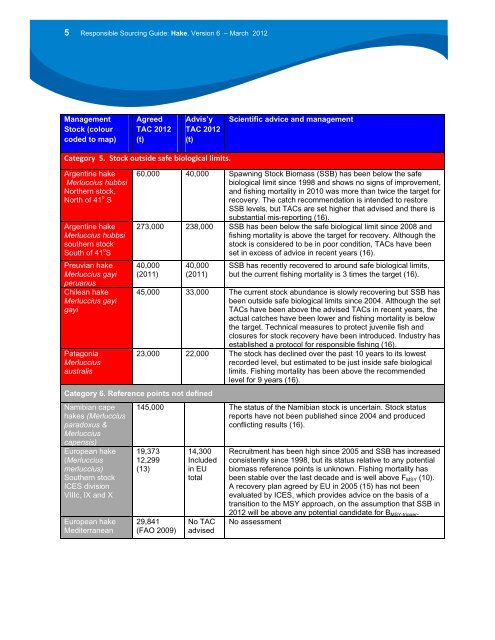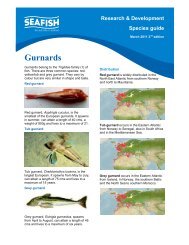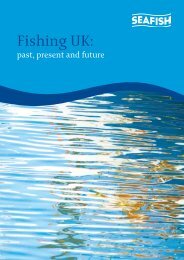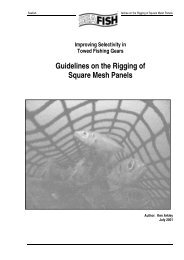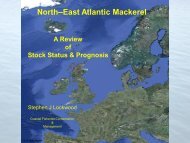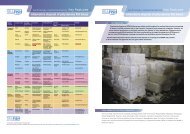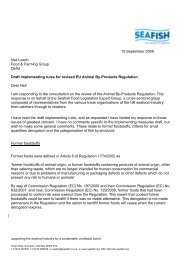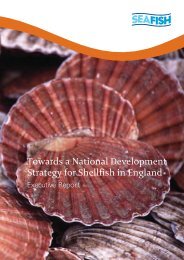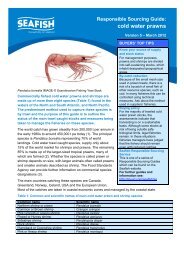Hake 2012 - Seafish
Hake 2012 - Seafish
Hake 2012 - Seafish
You also want an ePaper? Increase the reach of your titles
YUMPU automatically turns print PDFs into web optimized ePapers that Google loves.
5 Responsible Sourcing Guide: <strong>Hake</strong>. Version 6 – March <strong>2012</strong><br />
Management<br />
Stock (colour<br />
coded to map)<br />
Agreed<br />
TAC <strong>2012</strong><br />
(t)<br />
Advis’y<br />
TAC <strong>2012</strong><br />
(t)<br />
Scientific advice and management<br />
Category 5. Stock outside safe biological limits.<br />
Argentine hake<br />
Merluccius hubbsi<br />
Northern stock,<br />
North of 41 o S<br />
Argentine hake<br />
Merluccius hubbsi<br />
southern stock<br />
South of 41 o S<br />
Preuvian hake<br />
Merluccius gayi<br />
peruanus<br />
Chilean hake<br />
Merluccius gayi<br />
gayi<br />
Patagonia<br />
Merluccius<br />
australis<br />
60,000 40,000 Spawning Stock Biomass (SSB) has been below the safe<br />
biological limit since 1998 and shows no signs of improvement,<br />
and fishing mortality in 2010 was more than twice the target for<br />
recovery. The catch recommendation is intended to restore<br />
SSB levels, but TACs are set higher that advised and there is<br />
substantial mis-reporting (16).<br />
273,000 238,000 SSB has been below the safe biological limit since 2008 and<br />
fishing mortality is above the target for recovery. Although the<br />
stock is considered to be in poor condition, TACs have been<br />
set in excess of advice in recent years (16).<br />
40,000<br />
(2011)<br />
40,000<br />
(2011)<br />
SSB has recently recovered to around safe biological limits,<br />
but the current fishing mortality is 3 times the target (16).<br />
45,000 33,000 The current stock abundance is slowly recovering but SSB has<br />
been outside safe biological limits since 2004. Although the set<br />
TACs have been above the advised TACs in recent years, the<br />
actual catches have been lower and fishing mortality is below<br />
the target. Technical measures to protect juvenile fish and<br />
closures for stock recovery have been introduced. Industry has<br />
established a protocol for responsible fishing (16).<br />
23,000 22,000 The stock has declined over the past 10 years to its lowest<br />
recorded level, but estimated to be just inside safe biological<br />
limits. Fishing mortality has been above the recommended<br />
level for 9 years (16).<br />
Category 6. Reference points not defined<br />
Namibian cape<br />
hakes (Merluccius<br />
paradoxus &<br />
Merluccius<br />
capensis)<br />
European hake<br />
(Merluccius<br />
merluccius)<br />
Southern stock<br />
ICES division<br />
VIIIc, IX and X<br />
European hake<br />
Mediterranean<br />
145,000 The status of the Namibian stock is uncertain. Stock status<br />
reports have not been published since 2004 and produced<br />
conflicting results (16).<br />
19,373<br />
12,299<br />
(13)<br />
29,841<br />
(FAO 2009)<br />
14,300<br />
Included<br />
in EU<br />
total<br />
No TAC<br />
advised<br />
Recruitment has been high since 2005 and SSB has increased<br />
consistently since 1998, but its status relative to any potential<br />
biomass reference points is unknown. Fishing mortality has<br />
been stable over the last decade and is well above F MSY (10).<br />
A recovery plan agreed by EU in 2005 (15) has not been<br />
evaluated by ICES, which provides advice on the basis of a<br />
transition to the MSY approach, on the assumption that SSB in<br />
<strong>2012</strong> will be above any potential candidate for B MSY-trigger .<br />
No assessment


